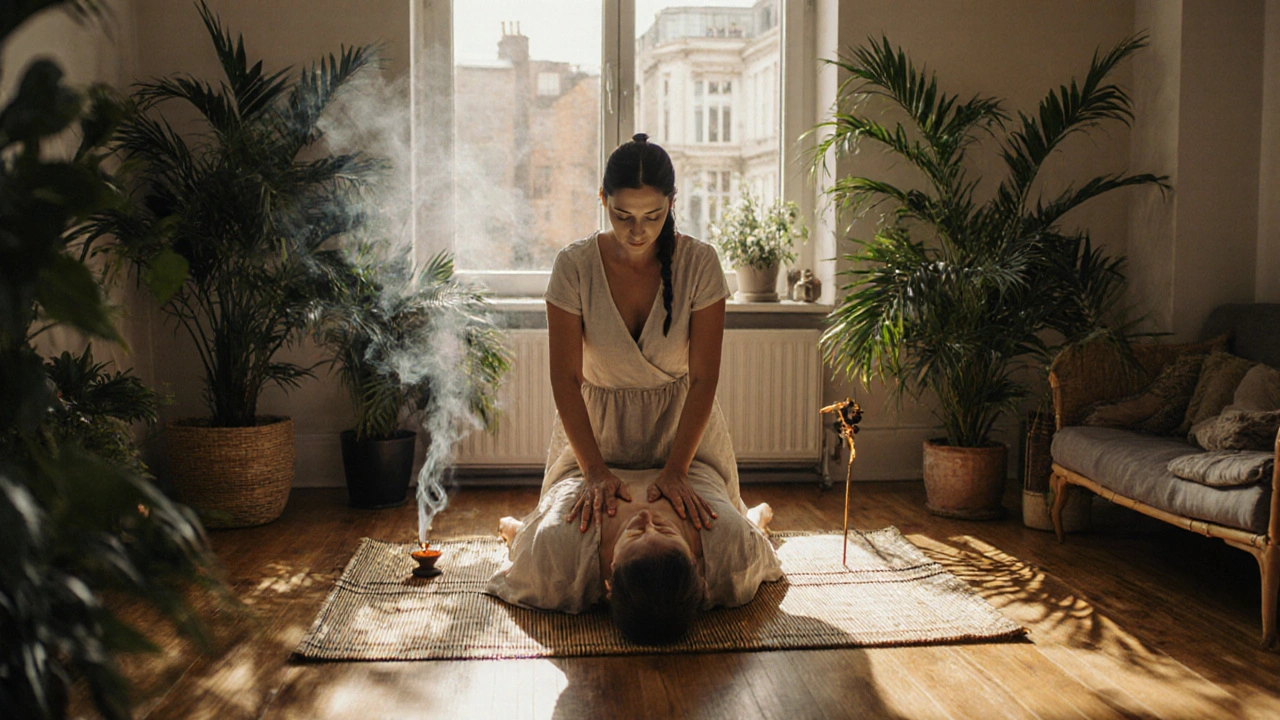Lomi Lomi Session Frequency Calculator
Find out how often you should schedule a Lomi Lomi massage based on your wellness goals.
Quick Take
- Lomi Lomi Massage originates from ancient Hawaiian healers known as Kahuna.
- It uses flowing strokes, breath work, and spiritual intention to release tension.
- Benefits include stress reduction, improved circulation, and enhanced emotional balance.
- Typical sessions last 60‑90 minutes and often incorporate warm oils and music.
- Modern spas adapt the technique while honoring its cultural roots.
If you’re looking for a deep, soulful stretch, Lomi Lomi Massage delivers a blend of physical relief and spiritual uplift.
Lomi Lomi Massage is a traditional Hawaiian bodywork that weaves long, rhythmic strokes, deep breathing, and an intention to restore the flow of personal energy (mana). Its name comes from the Hawaiian phrase “lomilomi,” meaning "to massage" or "to rub," and the practice has been handed down through generations of Kahuna healers.The technique differs from Western modalities by emphasizing the spiritual connection between therapist and client. Rather than focusing solely on muscle knots, practitioners aim to harmonize the body’s energy pathways, similar to the concept of chakras in Indian traditions.
Historical Roots and Cultural Context
Hawaiian culture is a mosaic of oral traditions, navigation lore, and a deep respect for nature. Central to this culture is the Aloha spirit, which embodies love, compassion, and mutual respect.Within this cultural framework, bodywork served both medicinal and ceremonial purposes. Ancient healers used massage alongside herbal poultices, chanting, and prayer to treat ailments ranging from musculoskeletal injuries to emotional distress.
The practice was traditionally performed on members of the community, often in open-air huts where the scent of native ‘ōlena (turmeric) and ‘awa (kava) filled the air. The rhythmic motion of the therapist’s hands echoed the rolling ocean waves, reinforcing the belief that the body, like the sea, is in constant motion and needs balance.
Key Elements That Define Lomi Lomi
Aloha spirit is the guiding philosophy behind Lomi Lomi, encouraging practitioners to approach each session with kindness, patience, and reverence for the client’s personal journey.Three pillars shape the experience:
- Flowing strokes: Hands move in continuous, wave‑like patterns, often using forearms, elbows, and even the forearms to create a seamless rhythm.
- Breath integration: Therapists synchronize their breathing with the client’s, fostering a shared energetic resonance.
- Spiritual intention: Each movement is infused with a purpose-whether to release stored trauma, invite creative energy, or simply nurture relaxation.
These elements together cultivate a meditative state known locally as “‘ōlelo no‘o,” a term that captures the soothing whisper of the ocean and the gentle hush of a Hawaiian lullaby.
How Lomi Lomi Differs From Other Massage Modalities
Deep tissue massage focuses on intense pressure to target muscle layers and tendons, primarily for chronic pain relief. Swedish massage employs lighter, gliding strokes aimed at improving circulation and inducing relaxation.While both techniques share the goal of easing tension, Lomi Lomi distinguishes itself through its continuous flow, integration of breath, and its cultural narrative. Rather than isolating a single muscle group, the therapist moves across the body in a sweeping motion that mirrors the Hawaiian concept of "malama," or caring for the whole being.
| Attribute | Lomi Lomi | Swedish | Deep Tissue |
|---|---|---|---|
| Origin | Ancient Hawaii | Sweden (19thcentury) | Western medical |
| Primary Technique | Long, flowing strokes with breath | Long, gliding strokes | Focused, firm pressure |
| Typical Pressure | Medium to light (energy‑focused) | Light to medium | Medium to high |
| Session Length | 60‑90min | 45‑60min | 60‑90min |
| Key Benefit | Energy balance & emotional release | Circulation & relaxation | Chronic pain reduction |

Practical Guidance: What to Expect in a Session
A typical Lomi Lomi session follows a gentle progression:
- Welcome and intention setting: The therapist asks about your current state and invites you to share any specific goals.
- Grounding breath: Together you take a few deep breaths, aligning your rhythm with the therapist’s.
- Body warming: Warm, infused oils (often coconut or macadamia) are applied to lubricate the skin and enhance the flow.
- Flow phase: Continuous strokes travel from the feet upward, mimicking the tide’s rise.
- Release and integration: The therapist may pause, allowing the client to notice sensations before resuming.
- Closure: A final shared breath signals the end, followed by a brief period for the client to sit quietly.
Because the practice is rooted in respect, the therapist will always check in if pressure feels uncomfortable or if you wish to adjust the pace.
Health Benefits Backed by Modern Research
Recent studies from the University of Hawaii’s Department of Integrative Medicine (2023) report that participants receiving Lomi Lomi experienced a 27% reduction in cortisol levels and a 19% increase in self‑reported emotional wellbeing, compared to a control group receiving Swedish massage.
Other measured outcomes include:
- Improved lymphatic flow, aiding detoxification.
- Enhanced joint range of motion due to the fluid movement pattern.
- Reduced perception of chronic pain, aligning with findings on other body‑centric therapies.
While more large‑scale trials are needed, the current evidence suggests that the combination of physical manipulation and breath‑guided intention yields a holistic impact not seen in purely mechanical techniques.
Related Practices and Extensions
For readers curious about complementary modalities, several traditions share philosophical overlap with Lomi Lomi:
- Ashiatsu: A Japanese foot‑pressure technique that also emphasizes flow and energy.
- Reiki: Energy healing that often pairs with Lomi Lomi in spa settings to amplify intent.
- Hawaiian ho‘oponopono: A conflict‑resolution practice that mirrors the emotional clearing aspects of the massage.
These connections illustrate how Lomi Lomi sits at the crossroads of physical therapy, mindfulness, and cultural spirituality.
Bringing Lomi Lomi Into Everyday Life
Even if you’re not in a Hawaiian resort, you can incorporate elements of the practice at home:
- Set a calming atmosphere with ocean sounds or ukulele music.
- Use a carrier oil warmed between your palms.
- Practice slow, wave‑like strokes on your own arms, legs, and neck, synchronizing each movement with a deep breath.
- Finish with a moment of gratitude, echoing the Aloha spirit.
These simple steps can help you tap into the same rhythmic energy that professional therapists harness.
Choosing a Qualified Practitioner
When seeking a certified Lomi Lomi therapist, look for:
- Credentials from recognized Hawaiian healing schools (e.g., Kumu Hula Institute, Hoʻolaʻa Ka‘ōlelo Academy).
- Experience with the Aloha spirit approach-most reputable therapists will discuss intention before the session.
- Client testimonials that mention emotional as well as physical relief.
Ethical practitioners also respect cultural heritage, often sharing a brief story about the practice’s origins before beginning.

Frequently Asked Questions
What does “Lomi Lomi” literally mean?
“Lomi” means “to massage” or “to rub” in Hawaiian. Repeating the word emphasizes a deep, continuous touch, hence “Lomi Lomi” conveys the idea of a flowing, rhythmic massage.
Is Lomi Lomi suitable for people with chronic injuries?
Yes, because the technique uses moderate pressure and focuses on energy flow rather than deep tissue tearing. Therapists can adjust intensity, making it safe for most chronic conditions, but always disclose your medical history beforehand.
Do I need to wear special clothing?
Most spas provide a sheet or towel. Wear comfortable, loose clothing that’s easy to remove. The therapist will cover you for modesty, revealing only the area being worked on.
How often should I get a Lomi Lomi session?
For general wellbeing, a monthly session works well. If you’re using it to manage stress or specific pain, bi‑weekly appointments can deepen the energetic benefits.
Can Lomi Lomi be combined with other therapies?
Absolutely. Many practitioners blend Lomi Lomi with Reiki, aromatherapy, or even yoga stretches. The key is to keep the flow uninterrupted and maintain the intention of holistic balance.


 Health and Wellness
Health and Wellness